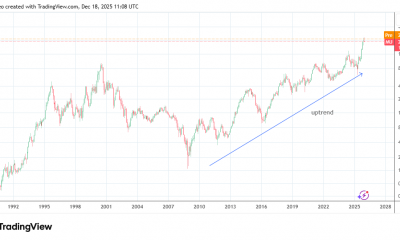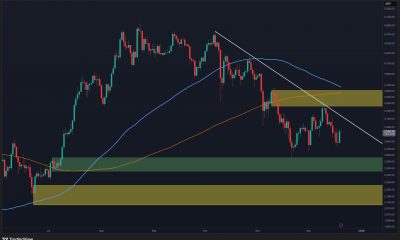

others
NZD/USD marches towards 0.6450 despite NZ job data misses consensus, Fed policy buzz – Crypto News
- NZD/USD is scaling towards 0.6450 as the USD Index has retreated after a short-lived pullback.
- The Federal Reserve is widely anticipated to announce a 25 bps interest rate hike to 4.50-4.75%.
- The Reserve Bank of New Zealand may continue its hawkish stance despite weak employment data.
- NZD/USD is testing the consolidation breakdown and is likely to display a fresh downside ahead.
NZD/USD has stretched its recovery above the critical resistance of 0.6440 in the early European session. The Kiwi asset displayed a recovery move after testing Tuesday’s low around 0.6415 due to subdued performance by the US Dollar Index (DXY). The USD Index is demonstrating topsy-turvy moves in a 101.70-101.80 range and is likely to display a downside break due to less anxiety among investors than usual ahead of the interest rate decision by the Federal Reserve (Fed).
S&P500 futures are failing to square off their losses that emerged in the Asian session, portraying a caution despite overall optimism in the market mood. Widely anticipated expression of further decline in the policy tightening pace by the Federal Reserve is not compelling the market participants to dump risk-sensitive assets. However, emerging United States recession fears due to the expectation of further stretch in the interest rate have shifted investors to the sidelines. The return generated by the 10-year US Treasury bonds is hovering around 3.51% after a mild correction.
Lower labor costs and consumer spending bolster the case for the less-hawkish Fed’s policy.
The Employment Cost Index (Q4) released on Tuesday was trimmed to 1.0% vs. the consensus of 1.1% and the prior release of 1.2%. Easing negotiating power for labor costs is music to the ears for the Federal Reserve, which is working hard to achieve price stability in the United States. Also, the Personal Consumption Expenditure (PCE) price index released last week showed that consumer spending contracted in December Christmas celebrations, which claims that the downside trend in the US Consumer Price Index (CPI) will continue further.
Economists at Goldman Sachs have come up with expectations for dictations by Federal Reserve chair Jerome Powell in February’s monetary policy meeting. They believe that “Since the FOMC last met in December, incoming data on wage growth and inflation have been encouraging, while signals on activity growth have been mixed and at times concerning. This ended up making the case for slowing the pace of rate hikes to 25 bp this week quite easy.
For further guidance, Goldman Sachs expects two additional 25bp hikes in March and May, but fewer might be needed if weak business confidence depresses hiring and investment.
US Employment data remains key ahead of Federal Reserve policy
The tight US labor market is losing its luster as firms are ditching the recruitment process due to a bleak economic outlook, Higher interest rates and lower retail demand has already forced the firms to suspend their expansion plans for some time. Also, a few firms are not operating at full capacity, which has trimmed the need for hiring fresh talent. This has also trimmed the negotiating power of employees to determine talent acquisition costs.
As per the consensus, the US Automatic Data Processing (ADP) (Jan) Employment data is seen at 170K, significantly lower than the prior release of 235K. The declining scale of job additions due to weaker economic projections is going to delight the Federal Reserve as it will trim inflation projections further.
Apart from the Employment data, US ISM Manufacturing PMI (Jan) will be of significant importance. Manufacturing activities are expected to be slowed to 48.0 vs. 48.4 in the prior release as firms are not deploying their entire operating capacity. However, the New Order Index is seen higher at 46.1 vs. the former release of 45.2. An upbeat forward demand might provide some cushion to the USD Index.
New Zealand Dollar holds strength despite weak jobs data
The New Zealand Dollar remained extremely volatile in the Asian session due to the release of the Employment data (Q4) and Caixin Manufacturing PMI data. The Employment Change dropped to 0.2% from the expectations of 0.3% and the earlier release of 1.3%. While the Unemployment Rate has increased to 3.4% from the consensus and the prior release of 3.3%. Apart from that Quarterly Labor cost index has landed at 1.1% lower than the estimates of 1.3% but similar to the prior release of 1.1%.
Steady employment bills and declining labor demand might delight the Reserve Bank of New Zealand (RBNZ), which is working with immense enthusiasm and zeal to achieve price stability. Reserve Bank of New Zealand Governor Adrian Orr might continue hiking interest rates as the inflation rate is still above 7%.
The Caixin manufacturing PMI landed at 49.2, lower than the expectations of 49.5 but higher than the earlier release of 49.0. It is worth noting that New Zealand is one of the leading trading partners of China and an unimpressive PMI has a vital impact on the New Zealand Dollar.
NZD/USD technical outlook
NZD/USD has sensed selling interest after testing the strength of the consolidation breakdown in the 0.6450-0.6470 range on a four-hour scale. On a broader note, the kiwi asset demonstrated signs of bearish reversal after a Double Top. charts pattern around December 13 high at 0.6515. An absence of stars Buying interest while attempting to overcome the 0.6515 resistance triggered selling pressure for the New Zealand Dollar.
The 50-period Exponential Moving Average (EMA) at 0.6460 is acting as a major barricade for the New Zealand Dollar.
Meanwhile, the Relative Strength Index (RSI) (14) has also slipped into the bearish range of 20.00-40.00, which indicates that the downside momentum is active now.
-

 Technology1 week ago
Technology1 week agoApple iPhone 16 price drops to ₹40,990 in Croma’s Cromtastic December Sale: How the deal works – Crypto News
-

 Technology1 week ago
Technology1 week agoApple iPhone 16 price drops to ₹40,990 in Croma’s Cromtastic December Sale: How the deal works – Crypto News
-

 Blockchain1 week ago
Blockchain1 week agoThis Week in Stablecoins: Winning the Back Office – Crypto News
-
Business1 week ago
XRP Holders Eye ‘Institutional Grade Yield’ as Ripple Engineer Details Upcoming XRPL Lending Protocol – Crypto News
-

 Technology1 week ago
Technology1 week agoApple iPhone 16 price drops to ₹40,990 in Croma’s Cromtastic December Sale: How the deal works – Crypto News
-

 Blockchain7 days ago
Blockchain7 days agoLitecoin Follows Bitcoin’s Momentum, But Resistance Looms At $79.60 – Crypto News
-

 Technology7 days ago
Technology7 days agoApple iPhone 15 price drops to ₹36,490 in Croma Cromtastic December Sale: How the deal works – Crypto News
-
Business1 week ago
DOGEBALL Presale: A Boost to Bring P2E Games Back into the Spotlight – Crypto News
-

 Technology6 days ago
Technology6 days agoSamsung Galaxy S25 Ultra price drops to ₹69,999 at Croma Cromtastic December Sale? Here’s how the deal works – Crypto News
-

 others1 week ago
others1 week agoAustralian Dollar loses as US Dollar advances before Michigan Sentiment Index – Crypto News
-
others1 week ago
XRP Holders Eye ‘Institutional Grade Yield’ as Ripple Engineer Details Upcoming XRPL Lending Protocol – Crypto News
-

 Blockchain1 week ago
Blockchain1 week agoCrypto Market Sentiment Not Fearful Enough For Bottom: Santiment – Crypto News
-
Business1 week ago
125 Crypto Firms Mount Unified Defense as Banks Push to Block Stablecoin Rewards – Crypto News
-
Business1 week ago
Ethereum Faces Selling Pressure as BitMEX Co-Founder Rotates $2M Into DeFi Tokens – Crypto News
-

 Blockchain1 week ago
Blockchain1 week agoCrypto Market Sentiment Not Fearful Enough For Bottom: Santiment – Crypto News
-

 Blockchain1 week ago
Blockchain1 week agoBitcoin on Track For 4th Annual Decline Despite Crypto Adoption – Crypto News
-

 others6 days ago
others6 days agoBillionaire Ray Dalio Says Bitcoin Has Problems, Calls Crypto Asset Inferior to Gold – Crypto News
-

 Cryptocurrency1 week ago
Cryptocurrency1 week agoWhy quantum computing is becoming a real concern for Bitcoin – Crypto News
-

 Blockchain1 week ago
Blockchain1 week agoCoinbase Launches Service to Help Businesses Create Tokens – Crypto News
-
Business1 week ago
Bitcoin Price Alarming Pattern Points to a Dip to $80k as $2.7b Options Expires Today – Crypto News
-

 Metaverse1 week ago
Metaverse1 week agoAI Tool of the Week: Transform marketing concepts instantly. – Crypto News
-
Technology1 week ago
Michael Saylor Sparks Debate Over Bitcoin’s Quantum Risk as Bitcoiners Dismiss It as ‘FUD’ – Crypto News
-

 Blockchain7 days ago
Blockchain7 days agoLitecoin Follows Bitcoin’s Momentum, But Resistance Looms At $79.60 – Crypto News
-

 Technology6 days ago
Technology6 days agoSam Altman teases ChatGPT Christmas Easter egg that turns your selfie into a Santa message: How it works – Crypto News
-

 Cryptocurrency6 days ago
Cryptocurrency6 days agoKey Drivers & Technical Outlook – Crypto News
-
Business1 week ago
Breaking: VanEck Discloses Fees and Staking Details for its Avalanche ETF – Crypto News
-

 Cryptocurrency1 week ago
Cryptocurrency1 week agoBTC at $143K, ETH above $4000: Citi issues bullish price forecasts as crypto market continues to struggle – Crypto News
-

 Cryptocurrency1 week ago
Cryptocurrency1 week agoIs ETH Ready for Sustained Recovery or Another Rejection Looms? – Crypto News
-

 Cryptocurrency1 week ago
Cryptocurrency1 week agoCrypto Industry Must Make Progress Before Trump Leaves Office: Etherealize Co-Founder – Crypto News
-

 Cryptocurrency1 week ago
Cryptocurrency1 week agoCrypto Industry Must Make Progress Before Trump Leaves Office: Etherealize Co-Founder – Crypto News
-

 Cryptocurrency1 week ago
Cryptocurrency1 week agoXRP Could Add Zero If Rally Is Short-Lived – Crypto News
-

 Cryptocurrency6 days ago
Cryptocurrency6 days agoCrypto Game Crashouts: The Biggest Shutdowns in 2025 – Crypto News
-
Technology6 days ago
Canary Capital Announces Major Changes to Its SUI ETF – Crypto News
-

 Cryptocurrency5 days ago
Cryptocurrency5 days agoIMF advances talks with El Salvador on Bitcoin policy and Chivo wallet future – Crypto News
-

 Cryptocurrency5 days ago
Cryptocurrency5 days agoIMF advances talks with El Salvador on Bitcoin policy and Chivo wallet future – Crypto News
-

 Blockchain1 week ago
Blockchain1 week agoCiti Pulls Blockchain Into the Banking Core – Crypto News
-

 Blockchain1 week ago
Blockchain1 week agoMastercard, BlackRock Join Middle East-Focused Blockchain Effort – Crypto News
-

 Technology1 week ago
Technology1 week agoFrom chibi to plushie: 7 Must-try AI portraits you can create with GPT Image 1.5 – Crypto News
-

 Technology1 week ago
Technology1 week agoFrom chibi to plushie: 7 Must-try AI portraits you can create with GPT Image 1.5 – Crypto News
-

 Cryptocurrency1 week ago
Cryptocurrency1 week agoBitMine Tops Up Treasury With $300 Million in Ethereum – Crypto News
-
others1 week ago
Trump to Interview BlackRock’s Rick Rieder as Fed Chair Shortlist Narrows to Four – Crypto News
-

 Blockchain1 week ago
Blockchain1 week agoBlackRock’s IBIT Ranks 6th in ETF Flows Despite Negative Returns – Crypto News
-

 others1 week ago
others1 week agoElliott Wave, seasonality, and cycles indicate more upside – Crypto News
-

 others1 week ago
others1 week agoElliott Wave, seasonality, and cycles indicate more upside – Crypto News
-

 Blockchain1 week ago
Blockchain1 week agoWhy XRP Price Is Playing Catch-Up Despite Successful ETF Launch: Analyst – Crypto News
-

 Blockchain1 week ago
Blockchain1 week agoBlockchain and AI Vibe-Coding To Dethrone Amazon Web Servies: Crypto exec – Crypto News
-

 Blockchain1 week ago
Blockchain1 week agoBanks Need XRP To Be Pricier—Here’s Why A Finance Expert Says So – Crypto News
-
Business1 week ago
Breaking: Rep. Max Miller Unveils Crypto Tax Bill, Includes De Minimis Rules for Stablecoins – Crypto News
-
others1 week ago
Australia CFTC AUD NC Net Positions down to $-629K from previous $-84.2K – Crypto News
-
Technology1 week ago
UK Crypto Market Entering a Phase of Maturity, Says Bybit Policy Director – Crypto News












